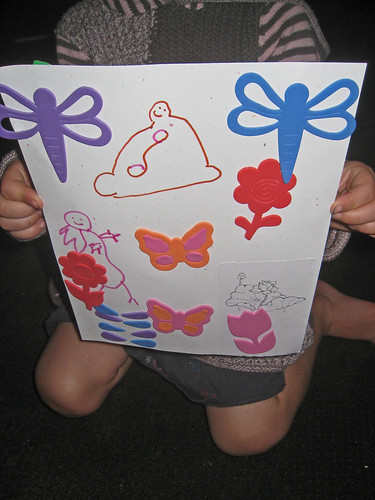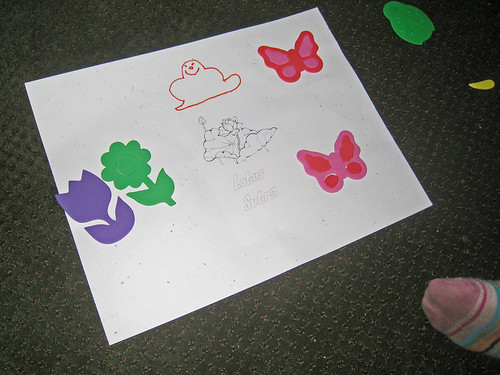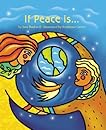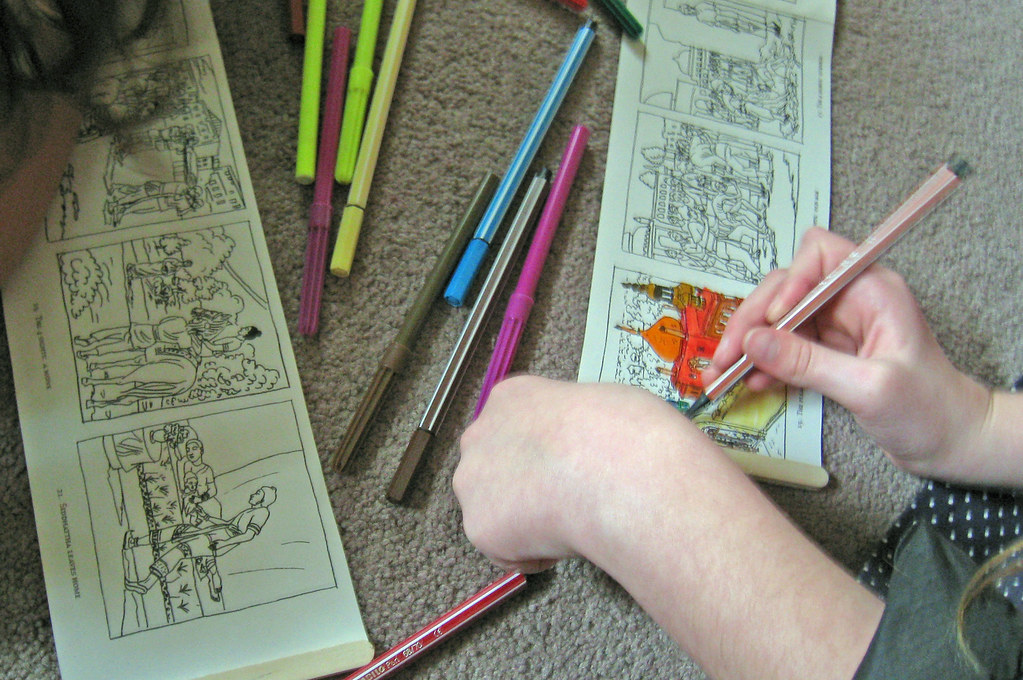Scene 1
Narrator: Let us visit the kingdom of Kapilavastu in the foothills of the Himalayan mountains, more than 2500 years ago. While she sleeps, a white elephant with six golden tusks visits the dreams of Queen Mahamaya.
[Queen lying down asleep. White elephant approaches with lotus flower.]
Narrator: In her dream, the elephant touches her right side with a lotus flower it holds in its trunk.
[Queen wakes up startled. Elephant vanishes.]
Queen: “What can this mean? Husband!”
[King Suddodana approaches.]
Queen: “I must see a holy man! A holy man can tell me what my dream means.”
[King Suddodana leaves and comes back with the holy man.]
Queen: “O wise man, a brilliant white elephant with six sparkling tusks visited me in my dream. He held a lotus flower, and in the flower there was a jewel. He touched me with the flower, and I was so startled I woke up.”
Holy man: “This is good news, my lady. You are going to have a baby, and your prince will be a great leader. He could be a great king, or he could be a great holy man, it all depends.”
Suddodana: “It depends on WHAT.”
Holy man: “If your son becomes troubled when he sees old age, sickness, and death, he will long for answers and will take up the life of a holy man. The world will rejoice.”
Narrator: This worried King Suddodana, because he wanted his son to rule his kingdom one day. The king began to make preparations. He had palaces built with beautiful gardens. He planned for his son to be happy all the time.
[these three leave. Queen returns, pillow in belly.]
Scene 2
Narrator: It is traditional at this time in India for a woman to return to her mother’s home when she is having a baby. Queen Mahamaya is on her way there. She and her handmaidens are passing a forest with flowering trees when she stops, grabs hold of an overhanging branch, and her baby is born. Sweet tea and flower blossoms rain from the sky.
[baby buddha stands up, takes seven steps (lotuses spring from steps) points one finger down, and one finger to the sky]
Baby Buddha: “Above the heavens and below the earth, I alone am the world honored one.”
[queen and king pair up with baby, then new queen and king with baby. Leave at ‘clear away’]
Narrator: Queen Mahamaya names her prince Siddhartha, and returns to the palace. Sadly, she becomes ill, and dies a week later. King Suddodana marries her sister, and she raises the prince as if he were her own. Growing up, the prince needs nothing. The king has all the servants clear away all evidence of decay and death while the prince sleeps. Even so, Prince Siddhartha notices how animals are treated, and this makes him sad.
Scene 3
[Siddhartha enters with Channa, pulling the charioteer along.]
Siddhartha: “Father, please may I leave the gardens and go outside the walls?
Suddodana: “No, son.”
Siddhartha: “But father, Channa will make sure I’m safe. I’ll be ok, I promise! Please may I see the city?”
Suddodana: “I’m sorry, no.”
Siddhartha: “Please, father. I’m a grown man. I have a wife. She is going to have my child. I should take my place as your heir.”
Suddodana: (sighs) “Oh well. I suppose you must. You may go tomorrow, but you must stay with Channa at all times. Promise me.”
Siddhartha: “I promise.”
Narrator: The king relents because he has a plan. He quickly sends his men to the city with orders for the people to keep the old and sick people indoors. He orders all the streets cleaned, gives the people new clothes, and new plants for their gardens. No funerals are allowed. Everybody must smile and look happy for the prince. But despite all the King’s efforts, Siddhartha sees an old woman….a sick man….a dead man all wrapped in sheets….and a holy man so calm and peaceful.
[Siddhartha and Channa see old woman crooked with walking stick, sick man lying down, dead man with sheets, holy man in robes. They leave. New scene:]
Siddhartha: “Channa, I must leave my home. I must find the answer to all this suffering.”
Channa: “Your father will never allow it.”
Siddhartha: “I know. I can’t bear to say goodbye to my beautiful wife and our new baby. I will leave at night, and you will help me.”
Narrator: “Channa takes the prince out of the city. The prince gives Channa his royal clothes and jewels and walks away. His horse and Channa are both crying. Siddhartha chops off his hair, and puts on the discarded tattered yellow robe of a hunter.
Scene 4
[Gautama sits down as the narrator speaks.]
Narrator: Siddhartha Gautama looks for a holy man to be his teacher. None can teach him how to end suffering. He meets five monks who show him the practices of eating very little and causing himself pain. They say THIS is the way to Truth. Gautama practices this way until he almost dies, he is so thin.
[a girl comes along and leaves a bowl at Gautama’s feet. Gautama picks up the bowl, eats, puts the bowl down. Sits. Then gets up and stretches and smiles.]
Gautama: “Ahhh! I feel so much better! My mind is clear. The pleasures of the palace did not help me to understand the Truth, nor was it right to starve myself. Through a Middle Way I can find the Truth. I am sure of it.”
[(bodhi tree moved in place) Gautama splashes himself in the ‘river’ and goes to sit under the bodhi tree.]
Gautama: “I will not leave this seat until I have found the Truth.”
[while narrator speaks, Mara enters, glaring. Demons enter, rush at Gautama, try to scare him. Try to make him giggle. Demons leave. (thunder, snake umbrella rises over) Beautiful dancers return, dance in front of him.
Narrator: Seeing that Gautama could actually overcome his ignorance and desire, Mara, the Great Distractor, joins Gautama under his tree. He calls up his demons, who rush at Gautama, try to scare him. The demons try all kinds of things to move Gautama from his seat. Siddhartha Gautama does not move. The demons throw rocks at him. The rocks turn into flowers. The demons give up. Mara calls up thunder and lightning…………..Siddhartha does not move, and the King of the Cobras shelters Siddhartha under his hood. Mara calls up beautiful dancers. Gautama does not move.
Mara: Who do you think you are?! You don’t have what it takes!
[Gautama calmly reaches down with one hand and touches the earth.]
Earth: I am your witness. You have what it takes.
[Mara gives up, and leaves. Gautama sits. A small light appears …Crack of the wooden blocks.]
Buddha: That’s it! That’s it! All…. illuminated!
Scene 5
[The Buddha gets up, stands and looks at audience, gesture with hands as narrator says ‘teaches many years’. Lies down on side when narrator says ‘right up to his death’. Ananda approaches, wipes his forehead.]
Narrator: Thus, Siddhartha Gautama becomes the Buddha, the Awakened One, at the age of 35. He teaches many years, giving us many profound lessons, such as the 4 Noble Truths, that is that, One, we all experience suffering, Two, the cause of suffering is attachment, three, we can end suffering by ending attachment, and four, we can end attachment by following the Eightfold Path. He teaches right up to his death at the age of 80. Ananda takes care of him at his deathbed.
[many followers gather around, wringing hands, crying, pulling hair.]
Ananda: Please don’t die. If you die, who will be our teacher? We need you. Who will show us the way to enlightenment?
Buddha: Do not be sad when I die, my friends. Everything that has a beginning has an ending. The world goes on. Didn’t I teach you that you must find your own way to the Truth?
Ananda: Yes.
Buddha: I have taught all I could. I held nothing back. You have everything you need. The Dharma is your light and your refuge in this world. Remember, you must be your own light.
Props: pillow, elephant tusks, 7 lotus flowers, bower/branch, walking stick, sheets, bodhi tree (umbrella), large cobra snake head
 During the last minute of meditation, (the kids meditated about four minutes) I broke the silence and asked the kids to think of something that helps them feel comfortable and safe, or something that they can do for others that helps others feel safe and comfortable. Then, for check-in, I asked them to share what they thought of. Sometimes the kids are shy with check-in, and this strategy worked well. They were able to combine the thoughtfulness of meditative mind with looking within for a way they handle feelings. Then, even the shy ones had something to say in check-in because they were prepared. A couple chose to demonstrate by covering their heads with their jackets. As soon as one said he liked climbing trees, that became a theme. One boy answered both questions by saying he liked to skateboard and teaching skateboarding.
During the last minute of meditation, (the kids meditated about four minutes) I broke the silence and asked the kids to think of something that helps them feel comfortable and safe, or something that they can do for others that helps others feel safe and comfortable. Then, for check-in, I asked them to share what they thought of. Sometimes the kids are shy with check-in, and this strategy worked well. They were able to combine the thoughtfulness of meditative mind with looking within for a way they handle feelings. Then, even the shy ones had something to say in check-in because they were prepared. A couple chose to demonstrate by covering their heads with their jackets. As soon as one said he liked climbing trees, that became a theme. One boy answered both questions by saying he liked to skateboard and teaching skateboarding.



























